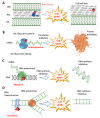Revisiting Antibiotic Resistance: Mechanistic Foundations to Evolutionary Outlook
- PMID: 35052917
- PMCID: PMC8773413
- DOI: 10.3390/antibiotics11010040
Revisiting Antibiotic Resistance: Mechanistic Foundations to Evolutionary Outlook
Abstract
Antibiotics are the pivotal pillar of contemporary healthcare and have contributed towards its advancement over the decades. Antibiotic resistance emerged as a critical warning to public wellbeing because of unsuccessful management efforts. Resistance is a natural adaptive tool that offers selection pressure to bacteria, and hence cannot be stopped entirely but rather be slowed down. Antibiotic resistance mutations mostly diminish bacterial reproductive fitness in an environment without antibiotics; however, a fraction of resistant populations 'accidentally' emerge as the fittest and thrive in a specific environmental condition, thus favouring the origin of a successful resistant clone. Therefore, despite the time-to-time amendment of treatment regimens, antibiotic resistance has evolved relentlessly. According to the World Health Organization (WHO), we are rapidly approaching a 'post-antibiotic' era. The knowledge gap about antibiotic resistance and room for progress is evident and unified combating strategies to mitigate the inadvertent trends of resistance seem to be lacking. Hence, a comprehensive understanding of the genetic and evolutionary foundations of antibiotic resistance will be efficacious to implement policies to force-stop the emergence of resistant bacteria and treat already emerged ones. Prediction of possible evolutionary lineages of resistant bacteria could offer an unswerving impact in precision medicine. In this review, we will discuss the key molecular mechanisms of resistance development in clinical settings and their spontaneous evolution.
Keywords: adaptation; antibiotic resistance; bactericide; bacteriostatic; clonal interference; compensatory evolution; drug interaction; epistasis; evolution; mutant selection window.
Conflict of interest statement
The authors declare no conflict of interest.
Figures





References
Publication types
LinkOut - more resources
Full Text Sources
Miscellaneous

